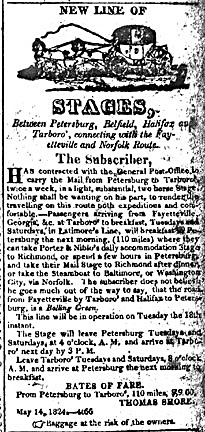North
Carolina
Business
History
Several individuals and businesses tried to organize transportation in the early era by creating regularly scheduled stage coach lines. These lines often had won the U. S. mail contracts and passengers were added for extra revenue. Some stage coach owners also owned hotels catering to
Stage Coaches




Here are some of the stage coach lines (additional information will be posted periodically) —
New Bern to Hillsborough stage line (late 1700s)
Suffolk, VA, to Wilmington, NC (1778) first postal route (stage coaches) in North Carolina, followed the old King's Highway route
Northern Stage line (1812) — Raleigh - Petersburg
Portsmouth (VA) to Elizabeth City (NC) — William Gregory of Elizabeth City owned the stageline and commenced operations around May 21, 1813.
The Norfolk Line (1818)
Fayetteville to Tarborough — part of The Norfolk Line. In 1829, C. & P. Mallett owned this stage line
Fayetteville to Newbern (1818)
Petersburg to Tarborough (1824) — operated by Thomas Shore beginning May 18, 1824; ran from Petersburg to Belfield, Halifax and Tarboro', carrying mail and passengers on two-horse stages. The route was 110 miles long. The stage would leave Petersburg two times a week at 4 a.m. and arrive in Tarboro' by 3 p.m. the next day. (Ad at right)
Western Stage (1828) — operated by C. & P. Mallet from Fayetteville to Rockingham, Wadesborough, etc. to Asheville. In Fayetteville, D. A. Davis was the agent. A Mr. Reinhardt owned this line and mail contract in 1830.
Fayetteville to Charleston Stage (1828+) — operated by C. & P. Mallet from Fayetteville to Charleston
Fayetteville to Camden Stage (1828+) — operated by C. & P. Mallet from Fayetteville to Camden
Fayetteville to Raleigh & Petersburg Stage (1829+) — operated by O. & D. Saltmarsh between Fayetteville and Raleigh and Petersburg.
Wilmington - Fayetteville Stage (1829) — owned by R. W. Latimer for travel between the two cities. In October 1830, C. & P. Mallett won the mail contract to operate this stage line.
Morganton - Asheville Stage line (1831) — operated by J. H. & R. W. Tate
Salem - Greenville (SC) Stage line (1831) — operated by Samuel & Dave Tate, Jr.
South-Western Line (1835) — Milton - Greensboro-Charlotte-Yorkville (SC); also a U. S. Mail carrier
The Great Western Stageline (1839 - ) — Salisbury - Asheville (through the Hickory Nut Gorge)
James Wells Stage (April 1849 - ) — Lincolnton to Yorkville (SC)
Goldsborough - Charlotte Stage (1849) — Goldsboro - Raleigh - Salisbury - Charlotte; predates the eventual route of the North Carolina Railroad.
Bland & Dunn's Great Northern & Southern Stage Line (1853) — connected Charlotte and Raleigh while the North Carolina Railroad was being constructed (completed in 1856).
United States Mail Line (1858 - 1959) — Salisbury, Statesville, Newton, Morganton, Marion, Pleasant Gardens, Swannanoa Gap, Asheville;C. S. Brown, contractor, Morganton.
United States Mail Line (1859) — Charlotte - Asheville (through the Hickory Nut Gorge)
Clemmons & Company Line (1860s) — Salem to many cities; owned by Edwin T. Clemmons and operated during the Civil War
S. H. Elliot & Company (1866 - ) — Cherryville to Rutherfordton
Fawlkes & Co. (1866 - ) — Sand Hills, S.C., to Wadesboro
Dowling's Stage (1872 - 1880) — owned by Lewis Dowing, the stage line used the 9-passenger Hattie Butner driven by John Pence; from Old Fort to Asheville; operated until the Western North Carolina Railroad was completed to Asheville.
Western Stage Line (1880s) — Hendersonville, Asheville, Warm Springs
Observer (Fayetteville) ad.

Industries
Laureates Contact
Us Home
2006 Copyright. CommunicationSolutions/ISI
for web site and content.
For additions or corrections, contact Ron
Vinson.